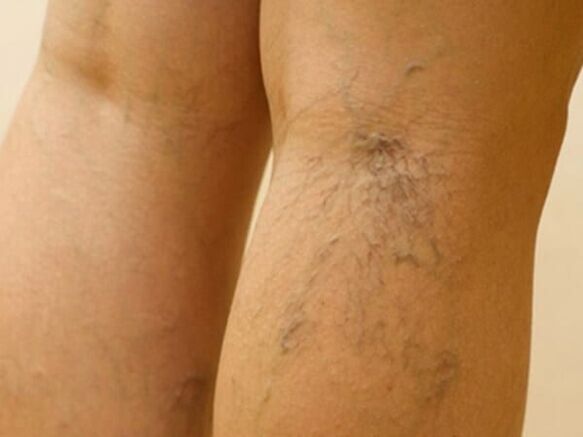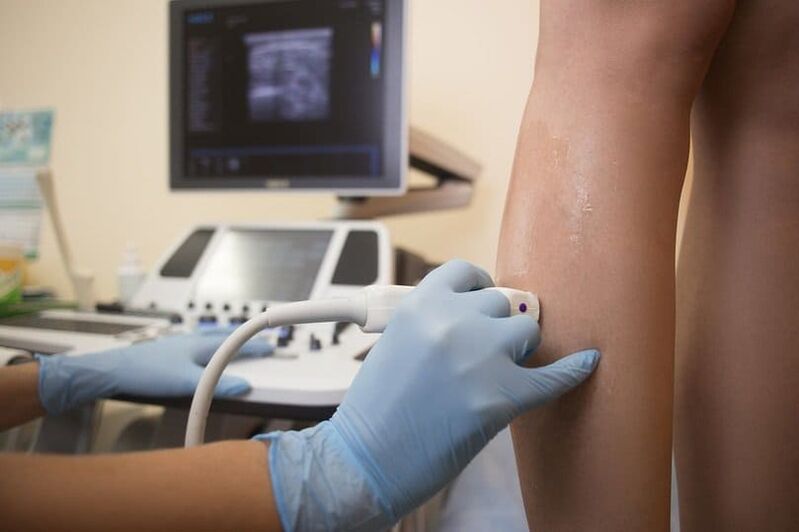Varicose veins is a disease of the veins, which is manifested by the enlargement, the formation of nodules and the thinning of the venous wall. It can affect various vessels, but most often occurs in the lower extremities.
In advanced cases, it causes trophic disorders in the affected area, the development of ulcers, eczema, even necrosis and gangrene. Therefore, it is important to make a correct diagnosis and start treatment in time.
How do varicose veins develop?
The exact causes of this disease are not known. However, the mechanism of how varicose veins start is well understood.
The venous network of the lower extremities is represented by deep and peripheral veins, as well as connecting (perforating) veins connecting them. Normally, blood flows through the veins to the heart, and from the peripheral veins to the deep veins.
This is done due to the muscle pump (contraction of the muscles of the lower extremities), the tone of the vascular wall and the work of the venous valves. The circulatory system is regulated by the vasomotor center in the brain.
But in case of violations in at least one of these connections, reverse blood flow occurs. At the same time, the peripheral vessels expand, the valves stop closing, causing further stagnation of blood in the peripheral circulation.
Under the pressure of blood, the venous wall continues to expand, which leads to the stretching of the veins and the formation of nodules. Valve failure increases, edema develops.
Compression of peripheral nerves sends a signal to the brain about the need to increase the tone of the vascular wall. This increases the blood pressure in the deep veins, and blood flows from them to the peripheral veins, causing them to dilate further. A vicious circle closes.
What causes varicose veins?
The true cause of varicose veins is unknown. However, it has been proven that a number of factors and physiological conditions contribute to its development.
Whom:
- Pregnancy (blood circulation in the lower limbs becomes difficult due to compression of the vessels in the abdominal cavity by the pregnant uterus);
- Obesity;
- Sedentary lifestyle;
- Genetic predisposition (weak valves or decreased tone of vascular walls);
- Hormonal imbalance (causes increased blood viscosity and difficulty in its flow);
- Postoperative condition (due to increased blood coagulation and bed rest);
- Occupations associated with standing for long periods of time.
In the presence of one of these conditions, it is necessary to take preventive measures to prevent the development of varicose veins. Especially if there are already any clinical manifestations.
Symptoms of varicose veins
The first signs of varicose veins:
- Pain and heaviness in the lower extremities;
- Swelling of the legs in the evening;
- The appearance of spider veins on the skin;
- Visible tense veins under the skin;
- Burning and itching sensation in the affected area;
- Cramps in the muscles of the lower limbs, especially at night.
Pains occur with varicose veins and intensify by the end of the day. They have an explosive, painful character. At the beginning of the disease, they disappear after rest, and therefore patients do not consult a doctor for a long time.
During the examination, edema, pastosia of the legs, telangiectasia are revealed, tension of the venous trunks, often painful, is palpated. What the skin of the legs with varicose veins looks like can be seen in the photo.

In the stage of severe decompensation, weakness, dizziness, fainting may occur. At the same time, trophic disorders are noticeable on the skin, ulcers, dermatitis and eczema develop. By visiting the doctor on time, severe manifestations of varicose veins can be prevented.
Types of varicose veins
Varicose veins have the following types:
- Varicose veins of the lower extremities (the most common option);
- Varicose veins of the upper extremities;
- Varicose veins of small pelvic veins (including varicose veins of childhood);
- varicose veins of internal organs (esophagus, stomach, intestines, etc. );
- Varicose veins on the face.
The most studied type is varicose veins of the lower extremities. It happens most often and is usually what they mean when talking about this disease. Most patients do not know if they have internal varicose veins and how they manifest themselves until they encounter them.
Stages of development of varicose veins:
| The stage of the disease | Clinical manifestations |
|---|---|
| 1 stage | There are no symptoms, varicose veins are detected only during instrumental examination |
| 2 stages | Severe leg syndrome, transient edema, spider veins on the skin |
| 3 stages | Persistent edema, skin pigmentation disorders, tight blood vessels and nodes appear, trophic disorders in the form of eczema |
| 4 stages | There are trophic ulcers, dermatitis, necrosis |
The smaller the stage, the easier the treatment and the better the prognosis for recovery.
Diagnosis of varicose veins
To make a diagnosis, in addition to examination data and characteristic complaints, a laboratory and instrumental examination of the patient is required.
Laboratory diagnostics
What tests should be done for varicose veins:
- Complete blood count with extended formula.
- Blood clotting tests:
- clotting time;
- prothrombin test;
- determination of antithrombin III, protein S and C;
- determination of homocysteine level;
- study of APTT index;
- Determining the level of D-dimer;
- determination of von Willebrand factor activity, etc.
- Biochemistry of blood.
- Hormone analysis.
- General urinalysis.
- functional tests.
Determining the state of the blood coagulation system is of crucial importance for the selection of treatment tactics and the prognosis of the development of the disease.
Instrumental diagnosis of varicose veins
Among the instrumental research methods used:
- ultrasound examination of veins;
- dopplerography;
- ultrasound duplex scanning of vessels (combination of ultrasound and dopplerography);
- angiography;
- photoplethysmography (PPG);
- phlebography;
- venous occlusal plethysmography (VOP).

With this type of research, the thickness of the vessel wall is measured, the state of the venous valves, whether there is reverse blood flow in the veins, etc. With the help of instrumental methods, it is possible not only to make a correct diagnosis, but also to accurately determine the stage of the disease.
Treatment of varicose veins
The fight against varicose veins includes medical (conservative and surgical treatment) and non-medical methods. The choice of a specific option depends on the stage of the disease and the degree of its external manifestations.
Conservative treatment of varicose veins
Surgeons and phlebologists were involved in the therapy of this disease. At the first signs of the disease, you should contact the doctors of these specialties. They will confirm the diagnosis and determine how to treat varicose veins in this case.
The following drug groups are used in conservative therapy:
- antiplatelet agents to thin the blood and prevent blood clots;
- anticoagulants that have a direct and indirect effect on improving the rheological properties of blood and preventing its thickening;
- phlebotonics to strengthen the vascular wall, herbal preparations with horse chestnut extract;
- if necessary, anti-inflammatory drugs (in case of inflammation in the vessel wall or surrounding tissues).
Most of these drugs are available both for oral administration (in tablets and capsules) and for external use (in the form of ointments, gels, creams). The doctor will tell you which form is best for this patient, depending on the specific clinical situation.
Surgical treatment of varicose veins
Conservative therapy will help to completely cure the disease only in the early stages. In advanced cases and with symptoms of decompensation, surgical treatment of varicose veins is necessary.
Surgery may involve removing the entire vein or just the affected area through incisions along the vein or in the inguinal fold and popliteal fossa (depending on the specific vein and its location). However, whenever possible, doctors try to perform a less traumatic procedure that causes the affected vessel to clot, which leads to its complete blockage.
Options for prudent operations:
- sclerotherapy (introduction of special sclerosing drugs through a catheter into the lumen of the vessel, causing tight adhesions, which are then replaced by connective tissue);
- endovasal laser coagulation (coagulation of the inner cavity of the vessel with a laser pulse);
- radiofrequency coagulation (sticking of vessel walls as a result of exposure to a high-frequency current pulse);
- miniphlebectomy (removal of a vein or its part through several punctures in the skin).
When coagulation is carried out in different ways, the result is the same - after gluing the walls of the vessel, its cavity will gradually be filled with connective tissue with the development of a complete barrier. In this case, the movement of blood will continue through the healthy veins, bypassing the clotted veins. Schemes of such operations can be seen in the video in this article.
Surgical methods have an indisputable advantage - the probability of recurrence after them is very low. In terms of the ratio of risks and effectiveness, less traumatic procedures are better. However, their price in clinics is quite high.
Non-drug treatment of varicose veins
It is quite possible to strengthen the walls of blood vessels with varicose veins without using tablets.
Non-medicinal means for this use:
- therapeutic exercises (to stimulate the muscle pump);
- compression stockings and elastic bandages (compression of the lower limbs stimulates the removal of blood from the vessels, normalizes the work of the venous valves, strengthens the vessel wall).
Compression stockings are recommended for all people at risk, especially:
- pregnant women;
- working on your feet all day;
- to all people during long flights on airplanes;
- patients taking drugs that promote blood clotting;
- sedentary people.
Prevention of varicose veins
Prevention of varicose veins is better to start before they appear. In addition, the recommended measures will help prevent other cardiovascular diseases.
Tips for prevention:
- give up all bad habits;
- carefully monitor your diet (except fatty, fried, smoked, sweet);
- strictly control your weight;
- lead an active lifestyle (more walking, running, cycling, rollerblading, etc. );
- wear comfortable shoes with small heels;
- daily contrast shower;
- at the end of the day, rest for 15 minutes with your feet up.
These measures will also help the identified varicose veins - to prevent further progression of the disease and the development of complications.
Many are wondering whether it is possible to play sports with varicose veins. The attending physician will give an accurate answer to this question, but in most cases, you can do sports, except for the heavy types associated with power loads.
Varicose veins are a common disease. Women suffer 4 times more often than men, this is associated with the characteristics of the hormonal background, pregnancy and a large list of female occupations that involve spending the entire working day on your feet.
However, timely prevention will help prevent the development of varicose veins for both men and women. The main thing is not to neglect the doctor's advice and do not forget the regularity of preventive measures.

















